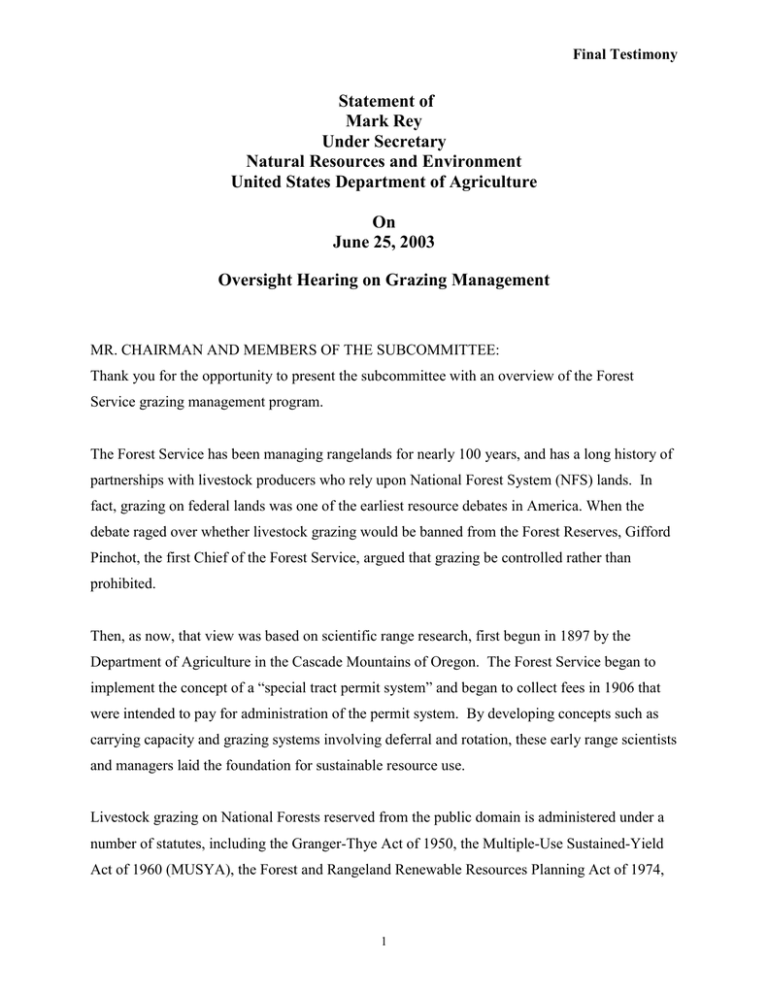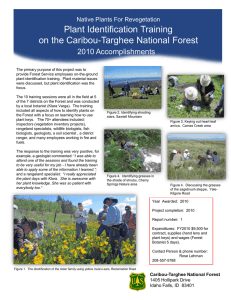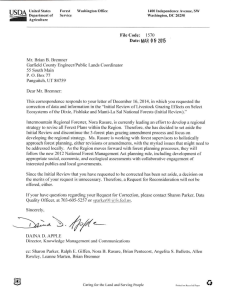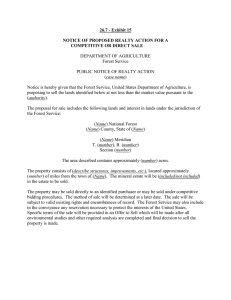Statement of Mark Rey Under Secretary Natural Resources and Environment
advertisement

Final Testimony Statement of Mark Rey Under Secretary Natural Resources and Environment United States Department of Agriculture On June 25, 2003 Oversight Hearing on Grazing Management MR. CHAIRMAN AND MEMBERS OF THE SUBCOMMITTEE: Thank you for the opportunity to present the subcommittee with an overview of the Forest Service grazing management program. The Forest Service has been managing rangelands for nearly 100 years, and has a long history of partnerships with livestock producers who rely upon National Forest System (NFS) lands. In fact, grazing on federal lands was one of the earliest resource debates in America. When the debate raged over whether livestock grazing would be banned from the Forest Reserves, Gifford Pinchot, the first Chief of the Forest Service, argued that grazing be controlled rather than prohibited. Then, as now, that view was based on scientific range research, first begun in 1897 by the Department of Agriculture in the Cascade Mountains of Oregon. The Forest Service began to implement the concept of a “special tract permit system” and began to collect fees in 1906 that were intended to pay for administration of the permit system. By developing concepts such as carrying capacity and grazing systems involving deferral and rotation, these early range scientists and managers laid the foundation for sustainable resource use. Livestock grazing on National Forests reserved from the public domain is administered under a number of statutes, including the Granger-Thye Act of 1950, the Multiple-Use Sustained-Yield Act of 1960 (MUSYA), the Forest and Rangeland Renewable Resources Planning Act of 1974, 1 Final Testimony and the Federal Land Policy and Management Act of 1976, among others. The MUSYA specifically provides, “It is the policy of the Congress that the National Forests are established and shall be administered for outdoor recreation, range, timber, watershed, and wildlife and fish purposes.” These laws augment the authority in the Organic Act of 1897, which established the Forest Service and directed the agency to regulate the use and occupancy of the forests to preserve them from destruction. Today, there are grazing allotments on nearly half of all National Forest System lands, approximately 90 million acres of land in 33 states. The Forest Service administers approximately 8800 allotments, which have over 9500 livestock permits, about 9.9 million animal unit months of grazing by cattle, horses, sheep, and goats. Nearly all this permitted grazing is located in the Western states (99%), with only about one percent occurring in the Eastern forests. Trends in Rangeland Management Rangeland is an important component of ecosystem diversity at a national scale. Rangeland health is dependent on sustainable management. The Forest Service works with other land managers to ensure the rangeland is productive for current and future use. Invasions of exotic species, fire, drought, and overgrazing are examples of agents and processes that have occurred beyond their range of historic variation on U.S. rangelands during the past 150 years, and have helped to reduce the productivity of rangelands over time. One of the biggest threats to rangeland is fragmentation through land conversion. Years ago, the national forests and grasslands were buffered by miles of rural landscape and rangeland. Now they are increasingly part of the wildland/urban interface and development. The Forest Service believes this change has relevance for public lands policy in the future. We want to ensure our policies keep ranches and working forests in operation, to keep the land whole, in the best tradition of conservation. 2 Final Testimony When properly managed, grasslands and shrublands can contribute to cleaner water supplies, healthy riparian areas and reduced sediment loadings in streams and other water bodies. These lands are vital for the production of forage for domestic livestock and provide forage and habitat for maintaining healthy wildlife populations. These lands also improve the aesthetic character of the landscape, provide scenic vistas and open spaces, provide for recreational activities, and protect the soil from water and wind erosion. To restore and protect rangeland and grasslands the Forest Service and the Natural Resources Conservation Service (NRCS) are working cooperatively to provide both financial and technical assistance to farmers and ranchers. Through the NRCS Grazing Lands Conservation Initiative (GLCI), owners of ranchland and pasture have developed grazing management plans for more than 80 million acres of grazing land since 1999. In addition to GLCI, the Department of Agriculture recently announced deployment of a new Grassland Reserve Program (GRP), authorized in the 2002 Farm Bill. Beginning June 30, the GRP will provide cost share and financial incentives to help landowners restore and protect grassland, rangeland, pastureland, shrubland and certain other lands. The program will conserve valuable grasslands by helping maintain viable ranching operations. GRP offers producers several enrollment options, including permanent easements, 30-year easements, rental agreements and restoration agreements. The Forest Service will have the ability to hold the conservation easement under this program. Grazing Permit Administration The National Environmental Policy Act (NEPA) and other environmental laws require the Forest Service to evaluate the environmental effects of livestock grazing on NFS land before authorizing this activity. Forest Service decisions in this area are subject to administrative appeals and judicial review. 3 Final Testimony In 1995, approximately ½ of all Forest Service grazing permits were due to expire. The Forest Service faced a daunting challenge to complete the NEPA process on these grazing allotments before they expired. In order to prevent a major disruption to livestock grazing on National Forest System lands associated with the expiration of approximately 4,500 Forest Service grazing permits, Congress enacted Section 504 of Public Law 104-19 (the “Rescissions Act”). Section 504 directed the Chief to identify grazing allotments that “needed” NEPA analysis and to “establish and adhere to” a schedule for the completion of that analysis. In early 1996, the Forest Service identified 6,886 grazing allotments on National Forest System lands that needed NEPA analysis at that time and established a schedule to complete these analyses by 2010. By the end of 2002, the Forest Service has completed NEPA analyses on more than 2,300 of the 6,886 grazing allotments listed on the schedule, or just over one-third of the total required. Unfortunately, it is only about half of the 4,527 allotments that had been scheduled for completion during this time. In the 2003 Consolidated Appropriations Resolution, Public Law 108-7 (as amended by the 2003 Emergency Wartime Supplemental Appropriations Act) Congress enacted Section 328, which directed the Secretary of Agriculture to renew grazing permits for those permittees whose permit expired prior to or during fiscal year 2003. NEPA analyses would still have to be completed on these allotments and the terms and conditions of the renewed grazing permit will remain in effect until such time as the analysis was completed. The Forest Service is continuing to complete NEPA analyses at the rate of 150 to 200 allotments per year for those grazing allotments on the 1996 schedule. We remain committed to completing this task without disrupting permitted livestock grazing activities, which consist of family-run operations, seventy-percent dependent on the use of NFS land for their livelihood. 4 Final Testimony Streamlined Permit Process The current decision-making procedure to authorize livestock grazing or other activities on rangelands administered by the Forest Service is inflexible, unwieldy, time-consuming, and expensive. For several years, the Forest Service has evaluated alternative procedures that would satisfy our legal obligations, provide the agency with management flexibility, shorten the decision-making time, and reduce the cost to the taxpayer associated with rangeland management decisions. We believe that this can be accomplished without compromising the integrity of the decision-making process or the condition of the land. The objective of these new procedures will be to protect the public’s natural resources and financial interests, while providing equitable treatment for permittees through adaptive management. Recently, we have begun discussions with our colleagues at BLM and the Council on Environmental Quality (CEQ) to discuss the challenges of complying with NEPA in a timely and effective manner. It has not been unusual for the Forest Service to take two or more years to complete the NEPA process for a single grazing allotment. This is unacceptable. We are considering a number of ideas and plan to develop recommendations for improvement by the end of the year. In this regard, we appreciate the April 7, 2003, letter from seven Senators, including Members of this distinguished Subcommittee, to CEQ regarding the issue of NEPA compliance for grazing permit renewals.” Additionally, the Forest Service is preparing a new chapter in the Forest Service Handbook on rangeland management decision-making. Drought – Forage and Water For the past 5 to 7 years drought has persisted over much of the Western United States. At present, “exceptional” drought (the highest level) is centered on the panhandle of Utah, Southeast Idaho and Southwestern Wyoming. Radiating from this center, extreme to abnormally dry conditions exist within the Intermountain area, Southeast Oregon, the Southwest, the Rockies, and large portions of the Great Plains continuing down to the Gulf Coast. 5 Final Testimony Predictions for this year call for more dry weather throughout most of the West. Although there has been some spring precipitation over wide areas, most of the West continues to have a significant water deficit. It will take a number of years of higher than average rainfall to recover from the drought. In 2002, significant reductions in grazing use on National Forest System lands occurred throughout the Interior West and the Western Great Plains. Although it is still too early to know the full effects of the drought, reductions in grazing use for 2003 could equal those of last year. The Forest Service has actively coordinated drought management with Federal, State, and local government agencies and officials. The agency is actively participating on national, State, and local drought task forces coordinating drought relief to our permittees. We are working closely with industry representatives to provide up-front information about what we are doing and seeking input from them as to their needs. Locally, the Forest Service is managing drought impacts on a case-by-case basis. District Rangers and Forest Supervisors are working hard to provide the greatest amount of flexibility to permittees when it comes to changes in their use or impacts to their operations. Local officials are communicating early in the process to ensure the permittee is informed and has enough time to implement temporary changes or a long-term strategy. The Agency is coordinating with universities and user groups to best address the concerns at the local level. The Forest Service will continue to do so until we return to more normal conditions. In this time of critical forage and feed shortage, the Department is sensitive to the livestock producers’ needs while we work to ensure our actions are consistent with the purpose of good land stewardship. The Forest Service will continue to work with permittees, local groups and the State to develop drought management plans and identify restocking criteria where needed. Monitoring The ecological conditions of rangelands affect the social and economic stability of many rural communities. To assure these lands are capable of providing sustainable products for future 6 Final Testimony generations the ecological condition of these lands are monitored to specific standards. Implementation and effectiveness monitoring are the two types of monitoring which the Agency uses. Implementation monitoring is an annual measurement of vegetation to assure permit compliance with written instructions for either the permittee, or the Forest Service, or both. Effectiveness monitoring is long-term (every 5-6 years) where vegetation is monitored to assess prescriptions and objectives set forth in Forest Plans, allotment management plans or other relevant documents. Effectiveness monitoring is the basis for determining what if any modifications to the grazing strategy are needed to provide ecosystem sustainability. On some National Forests there is an established program which encourages the grazing permittee to conduct much of the implementation monitoring. In some instances the permittee, working in conjunction with other Federal agencies, universities and rangeland consultants, have developed a successful, collaborative monitoring program. The Forest Service is currently working with industry representatives to develop a national Memorandum of Understanding that will improve our cooperative implementation and effectiveness monitoring. This is a great opportunity for both entities to collaborate on long-term goals and objectives for rangeland resources. Congress, in its FY 2003 House Interior Appropriations Report asked the Secretary of the Interior and the Secretary of Agriculture to prepare a report on how they would address the longterm monitoring, ecological classification of vegetation and soil survey work which is needed to efficiently address rangeland conditions. The report should be available later this year. While there have been improvements in rangeland conditions on National Forest System lands since the Forest Service started regulating livestock grazing over 100 years ago we must continue to work collaboratively with our partners to restore and rehabilitate rangeland areas so they may be productive for current and future generations. Managing rangeland resources is an important task for the Forest Service, and we appreciate the Subcommittee’s interest in this subject. 7 Final Testimony Coordination between the Forest Service and the Bureau of Land Management and Local Communities Some National Forest System lands are intermingled with or adjacent to lands administered by the Bureau of Land Management (BLM). The Forest Service is working with the BLM on common resource issues including grazing use, to improve consistency and resource management across agency boundaries. We have long standing agreements that provide for interagency management and cooperation. The Forest Service and BLM also have a number of co-located offices operating under the banner of Service First. In these situations, the management official in charge manages both National Forest System lands, as well as BLM lands. In some cases the two agencies entered into an agreement that provides for one Federal agency to manage another’s grazing program under their respective authorities. In addition, there are numerous planning groups helping to manage lands of mixed ownership. These groups include coordinated resource management (CRM) groups, watershed management groups and others. The underlying goal is to manage an area as a landscape. At the national level, the Forest Service and BLM have been coordinating revisions of our respective manuals and handbooks, with the goal of achieving greater consistency in our grazing programs while being mindful of the different enabling legislation governing our respective agencies. We have been cooperating in the development of standard monitoring techniques, as well as protocols for inventorying rangeland resources. We are working to coordinate the use of data for managing adjacent lands at the local level. The Forest Service will continue to work closely with the BLM and local communities to manage our Federals lands in a cooperative fashion to ensure the rangeland is healthy, sustainable, and productive. This concludes my statement. I would be pleased to answer any questions that you may have. 8




